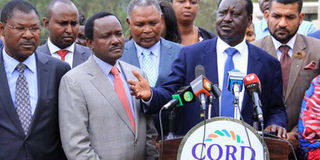Opposition merger will introduce new dynamic in 2017

Cord leader Raila Odinga, and other members, addresses reporters at Capitol Hill on December 22, 2016. They plan to form a major coalition. PHOTO | JEFF ANGOTE | NATION MEDIA GROUP
What you need to know:
- Here, the main question is whether the party will be able to mobilise the same kind of support as the Jubilee Alliance in 2013.
- If the opposition agree to a single presidential candidate this would significantly strengthen their position.
The year 2016 will likely be remembered as the year that Kenya’s political alliances held and the government managed to retain substantial support despite significant problems.
The latter includes political protests around the Independent and Electoral Boundaries Commission (IEBC); an increase in extra-judicial killings; and claims of unprecedented corruption.
In turn, 2017 will likely be remembered, first and foremost, for what happens before, during and after the sixth General Election since the country returned to multi-party politics in the early 1990s.
Given delays in the appointment of new electoral commissioners, the first question is whether the elections will go ahead as planned in August, or they will be delayed until later on in the year.
This is an important question given that the push for new commissioners was linked to questions about the IEBC’s credibility following revelations of procurement scandals and another disputed election.
In turn, new commissioners will need to make some significant decisions – for example, about the types of technology to be used – and have time to carry out these initiatives, if they are to have a chance of boosting public confidence in this troubled body.
Another issue relates to the national alliances that will contest the election.
IN OFFING
On the one hand, lies the new Jubilee Party, which brings together President Uhuru Kenyatta’s The National Alliance (TNA) and Deputy President William Ruto’s United Republican Party (URP).
Here, the main question is whether the party will be able to mobilise the same kind of support as the Jubilee Alliance in 2013 – with eyes focused on the Rift Valley vote in particular.
On the opposition side, ongoing discussions about the formation of a National Super Alliance (Nasa) raises the prospect of a united front – from ODM and Wiper led by Raila Odinga and Kalonzo Musyoka, respectively, to Moses Wetang’ula and FORD-Kenya, Musalia Mudavadi and the Amani National Coalition, and Gideon Moi and the Kenya African National Union (Kanu).
If the opposition agree to a single presidential candidate this would significantly strengthen their position.
Many feel that all politicians are simply hungry for power; that opposition leaders would likely be little different to the current government or that they would be less capable; and that there is little point in voting.
In turn, a single platform would help bring the traditional support bases of these different leaders together, and simultaneously undermine a burgeoning sense of political scepticism and apathy.
This could potentially help foster a sense that the opposition might win, which would likely increase voter turnout in opposition areas.
SIGNIFICANT CHALLENGE
However, for this to have maximum effect, the alliance would have to be formed by the end of the voter registration period early on in the year.
At the same time, the question of who would be Nasa’s presidential candidate poses a significant obstacle to the alliance ever getting off the ground.
This is then complicated by the fact that opposition politicians who are candidates for parliament, governorships and so forth, may not want to agree to a joint platform if this could potentially lead them to be pushed out of local level contests.
Finally, much attention will focus on county level contests – with competition for these seats much higher now that people are aware of the powers and resources that county governments control.
These campaigns will be driven by local rivalries and logics – in which personal ambition, ethnic mobilisation and other forms of localism will be active – but also by calculations about national power.
Dynamics will vary between counties in terms of both the level of tension and potential for violence, and the kind of cleavages witnessed.
This includes, for example, resource and border issues in places such as Turkana/Pokot and Kisumu/Nandi; tensions between different religious communities at certain counties at the Coast; the possible marginalisation of those who deem themselves to be the true ‘sons of the soil’ in certain cosmopolitan counties; and clashes between rival gangs associated with opposing groups of MCAs in some urban areas.
Such dynamics render the outcome, as well as the nature, of the 2017 elections highly uncertain.
However, this only provides further reason for why they will absorb much of the attention of analysts, activists, and candidates during the year.
Gabrielle Lynch is Associate Professor of Comparative Politics, University of Warwick. [email protected]; @GabrielleLynch6





